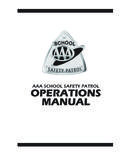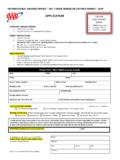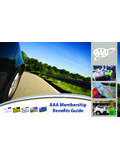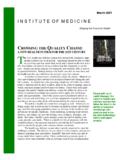Transcription of AAA FUEL QUALITY RESEARCH: Proprietary research into the ...
1 AAA National | 1000 AAA Drive | Heathrow, FL 32746 | AAA FUEL QUALITY research : Proprietary research into the effectiveness of fuel additive packages in commercially - available gasoline (this page intentionally left blank). 2016 American Automobile Association, Inc. 1. Abstract AAA conducted primary research in the area of fuel QUALITY to better understand the impact of detergent additive packages on engine cleanliness. These additives have been used in commercially available gasoline for more than 20 years to help keep fuel system components clean and prevent the buildup of carbon deposits on critical engine components such as fuel injectors, intake valves and combustion chamber surfaces. Such deposits disturb airflow and affect air/fuel ratios, which can lead to detonation, pre-ignition, incomplete combustion, reduced fuel economy and increased exhaust emissions.
2 [1]. In 1996 the Environmental Protection Agency (EPA) [2]established a standard that specified the lowest additive concentration (LAC) permissible for detergent additives used in gasoline sold in the United States. Those standards remain in place today. While this level of additives helped minimize certain deposits, some automakers felt the standards did not go far enough in reducing intake valve deposits. In 2004, a group of vehicle manufacturers created the TOP TIER [3] Detergent Gasoline program to develop a higher standard for gasoline detergent additives that better protects against intake valve deposits and general carbon buildup. Aside from the EPA's lowest additive concentration mandate, the TOP TIER Detergent Gasoline program is the only performance standard for gasoline deposit control performance, and is the focus of this report.
3 research Questions: 1. Are there differences in the quantity of intake valve and combustion-chamber deposits between engines operated on TOP TIER and non-TOP TIER gasoline? 2. What issues might be experienced by motorists who operate their vehicles' engines on non- TOP TIER gasoline? 3. Can existing engine carbon deposits be reduced or removed by switching to a gasoline that meets TOP TIER standards? 4. What are the current consumer trends in purchasing gasoline? 5. Is there a retail price difference between TOP TIER and non-TOP TIER gasoline? Key Findings: 1. The test engine operated on a TOP TIER gasoline averaged 19 times fewer intake valve deposits than when it was operated on non- TOP TIER gasoline. (based on the ASTM D6201. test - TOP TIER gasoline averaged of deposits per intake valve versus non- TOP TIER.)
4 Average of ). 2. Based upon secondary research findings, long-term use of a gasoline without an enhanced additive package can lead to reductions in fuel economy of 2-4%, drivability issues, and increased emissions. 2016 American Automobile Association, Inc. 2. 3. In most cases, carbon deposits can be reduced or removed from critical engine components1. by switching to a gasoline that meets TOP TIER standards. 4. Approximately six in ten drivers (63%) believe there is a difference in the QUALITY of gasoline sold by retailers, yet only (12%) of drivers purchase gasoline based upon its detergent additive package. The primary motivation for choosing a particular gas station is location /. convenience (75%), followed closely by the price of the fuel (73%). 5. Most TOP TIER gasolines do not cost significantly more than non-TOP TIER gasoline.
5 The average price difference between the TOP TIER and non-TOP TIER brands surveyed was three cents per gallon over a 12-month period. 1 Back side of intake valves, roof of combustion chamber, top of piston, and piston crown in the emissions-critical area above the top compression ring 2016 American Automobile Association, Inc. 3. Contents 1 Introduction .. 6. 2 Background of Fuel additives .. 8. 3 Gasoline and Detergent Additive 11. 4 Inquiry #1: Are there differences in the quantity of intake valve and combustion-chamber deposits between engines operated on TOP TIER gasoline and those operated on non-TOP TIER gasoline? .. 12. Objective .. 12. 12. Test Fuel Selection .. 14. Test Results .. 15. 5 Inquiry #2: What issues might be experienced by motorists who operate their vehicles' engines on a non-TOP TIER gasoline?
6 18. Objective .. 18. 19. Findings .. 19. 6 Inquiry #3: Can existing engine carbon deposits be reduced or removed by switching to a TOP TIER. gasoline? .. 20. Objective .. 20. 21. Test Results .. 22. 7 Inquiry #4: What are the current consumer trends in purchasing gasoline? .. 22. Objective .. 22. 23. Test Results .. 23. 8 Inquiry #5: Is there a retail price difference between TOP TIER and non-TOP TIER gasoline?.. 23. 9 Key Findings .. 24. 10 Summary Recommendations .. 25. 11 References .. 25. 12 Appendices .. 27. Fuel#1 IVD9-147 .. 27. Fuel#2 28. 2016 American Automobile Association, Inc. 4. Fuel#3- 29. Fuel#4- 30. Fuel#5-IVD9-150 .. 31. Fuel#6- 32. 2016 American Automobile Association, Inc. 5. 1 Introduction Extracting crude oil from the ground and transforming it into a product that motorists can use is a major undertaking that requires billions of dollars' of infrastructure in the form of drilling rigs, pipelines, tanker ships and refineries.
7 Crude oil is extracted from the ground through multiple techniques such as on-land and deep-water well drilling, oil sands extraction, hydraulic fracturing and more. Once obtained, the heavy crude oil is held in temporary storage tanks. The crude oil is then distributed to a network of 142 [4] refineries in the primarily through pipelines, although some is transported via tanker ships. The oil is then refined into various products such as gasoline, diesel, kerosene and jet fuel through the process of distillation. Figure 1: Crude Oil and Refined Petroleum Pipelines Image Source: AAA, Energy Information Administration dataset Refined gasoline is transported via trucks, tanker ships and barges, or pipelines to various distribution terminals across the country. However, the refined gasoline is still not ready for use by retailers because a detergent additive packages has not yet been blended into the fuel.
8 Base gasoline (fuel without additives ) from various refineries is usually stored in common tanks at the distribution terminal until a retail gas station places an order for the product. This is when the individual brands are created through the addition of Proprietary additive packages . As a tanker truck is being filled at the terminal, base gasoline is blended with a detergent additive package specific to that retailer. 2016 American Automobile Association, Inc. 6. Figure 2: Fuel distribution terminal and tanker truck Image Source: AAA. In addition to different additive packages , the makeup of base gasoline can also change based on season of the year, geographic region and local statutes. For example, many areas of the country undergo spring and fall switchovers between summer and winter base gasoline. Winter fuel has higher volatility for better cold-weather starting and running, while summer fuels have lower volatility for reduced evaporative emissions.
9 As shown on the chart below (fig. 3), several regions of the United States have boutique fuels with unique properties that are intended to reduce evaporative and exhaust emissions for vehicles in their region. These specially-refined base fuels, such as California's Reformulated Gasoline (RFG3), are inherently cleaner due to stringent requirements on olefins, aromatics, heavy ends (high boiling point molecules) and sulfur content [5]. While RFG3 and other boutique base fuels are cleaner than most other gasolines, they will still form engine carbon deposits without proper level of detergent additives . At the time of this report, there were fourteen different boutique fuel blends in the United States, which adds complexity to the distribution network and creates potential challenges for vehicle manufacturers when they have to track engine performance issues related to fuel type and QUALITY .
10 2016 American Automobile Association, Inc. 7. Figure 3: fuel map showing custom fuel blends per region Image Source: Exxon Mobile 2 Background of Fuel additives additives have been used in automotive fuels since the early 1900s to help prevent knocking and Over time, additional additives were developed to address various issues such as deposit formation in carburetor venturi around the throttle plates which could cause throttle sticking. Deposit control additives were first added to gasoline in the 1970s [5] to prevent carbon deposit formation on the intake valves. As electronic fuel injection systems began to arrive on the market in the 1980s automakers began experiencing issues with injectors sticking or becoming clogged due to contamination in the base fuel. These port-fuel injected engines sprayed fuel directly above the intake valves, which resulted in carbon build-up on the injector nozzle and backside of the intake valve.














